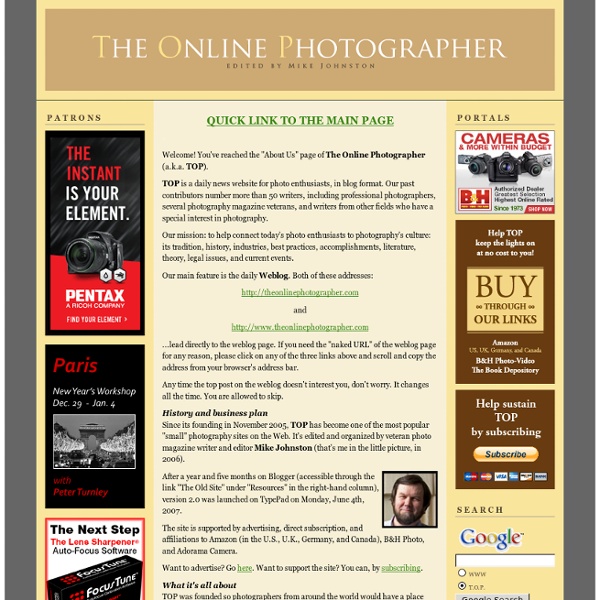The Online Photographer:

Free Digital Photography Tutorial Site
Tamron Blog: Angle of View
Jay Maisel Photography
100 Photography Tutorials for Professionals And Beginners
Sep132010 Photography as both a profession and a hobby is an incredibly expansive topic that covers a remarkably vast range of subjects from science and art. No matter where you lie on the professional spectrum, there is simply always more to learn. We spent countless hours scouring the web for the best content we could find and share with you, and today we’ll help you expand your knowledge with 100 photography related tutorials! 10 Top Photography Composition Rules “There are many composition guidelines which can be applied in almost any situation, to enhance the impact of a scene. RAW vs. “Graphic illustrations [and explanations] of the difference between RAW and JPEG (also called JPG). Understanding White Balance A basic discussion of white balance and how to respond to different lighting situations. White Balance “Use a simple device to get perfect color in all of your shots” Four Facts About High ISOs “What you need to know to get the most from today’s amazing high-ISO settings” Film Vs.
Cultural Self Improvement
Digital Photography Tips From The Top Floor
Blue Ridge Mountains Photography - Hendersonville Fine Art Photographer Dave Allen
Unique Photo Blog, News and Reviews « Unique Photo Blog, News and Reviews on the latest photography topics and products. The place where beginners to professionals come to learn and mingle.
Canon L Lens Series Information
What is the Canon "L" Lens Series? Good question - and many answers exist, but it is Canon's professional line (though used extensively by non-professionals) of EOS EF autofocus 35mm SLR and DSLR still camera lenses. Some say L stands for "Low Dispersion" - achieved by the UD lens elements found in these lenses. Watch the sidelines at the next professional sporting event you attend or watch on TV. About their L lenses, Canon says "these lenses use special optical technologies [such as] Ultra-low Dispersion UD glass, Super Low Dispersion glass, Fluorite elements, and Aspherical elements to truly push the optical envelope." OK so what does that mean - practically speaking? What you can get when you use Canon L lenses (if you do your part right) are amazing pictures. The above picture shows the Canon EF 70-200mm f/2.8 L IS USM Lens (left) compared to the Canon EF 100-400mm f/4.5-5.6 L IS USM Lens extended and retracted along with their lens hoods. Aren't they beautiful?!
Related:
Related:



